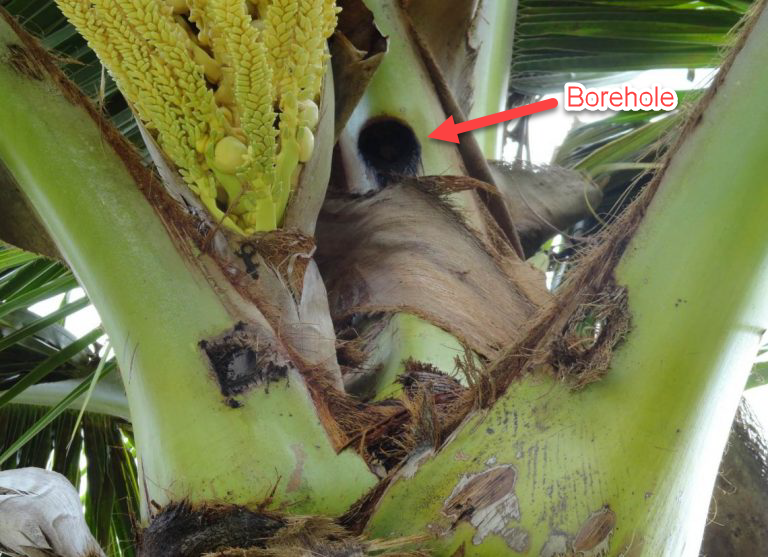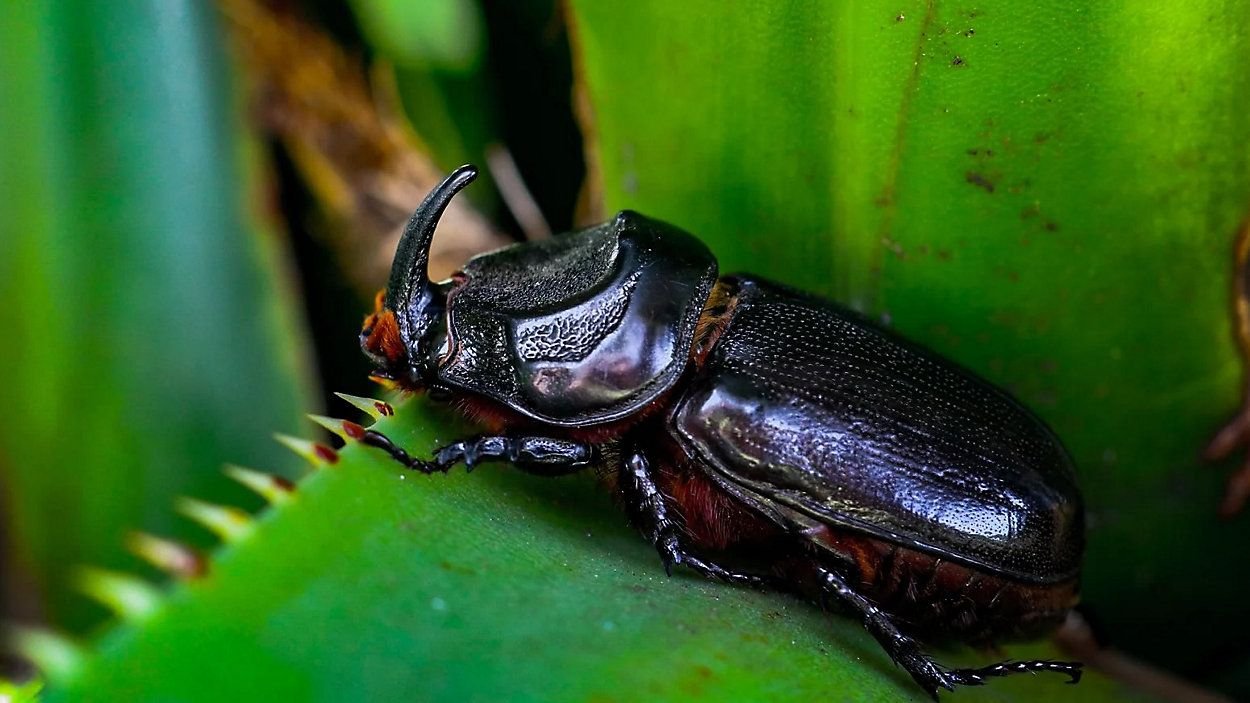Aloha Tree Savers & The Coconut Rhinoceros Beetle
What is the Coconut Rhinoceros Beetle?
The Rhinoceros beetle is a striking insect known for its impressive size and distinctive horns, which resemble those of a rhinoceros. Rhinoceros beetles are generally black or brown, and their strong bodies can reach sizes of up to 4 inches in length. They are primarily herbivorous, feeding on decaying wood and plant material.
Where did these beetles originate and how did they get to Hawaii?
Rhinoceros beetles are native to various tropical and subtropical regions, particularly in Asia and Africa. In Hawaii, they were introduced in the late 19th century, likely through agricultural importing ships.
What is the process for the beetle affecting the trees? What does it do to damage the trees?
Rhinoceros beetles primarily damage trees by feeding on their roots, particularly in palm species. Here's how the process works:
Feeding: Adult beetles burrow into the soil and use their strong mandibles to consume the roots and lower trunk of the trees. This feeding can disrupt the tree's nutrient and water uptake.
Infestation: The beetles can also lay eggs in the soil around the tree. When the larvae hatch, they continue to feed on the roots, further weakening the plant.
Impact: As the beetles damage the root system, trees may exhibit symptoms such as wilting, yellowing leaves, and stunted growth. In severe cases, this can lead to tree death, especially if the tree is already stressed from other factors.
Disease Transmission: Additionally, the beetles can introduce pathogens or fungi while feeding, compounding the damage to the tree.
How can you tell your tree has been damaged?
You can identify tree damage caused by rhinoceros beetles through several signs:
Wilting and Yellowing Leaves: Affected trees may show signs of stress, such as leaves wilting or turning yellow.
Stunted Growth: Trees might exhibit reduced growth rates or fail to produce new leaves.
Visible Holes or Cavities: You may see holes in the soil near the base of the tree, indicating where beetles have entered or fed.
4. Root Damage: If you can access the roots, look for signs of feeding, such as chewed or damaged roots.
5. Fungal Growth: You might notice mushrooms or fungal growth near the base of the tree, which can indicate that the tree is under stress or infected.
6. Bark Damage: In some cases, beetles may also damage the bark, leading to cracks or peeling.
If your trees are damaged, what are the steps you should take to reverse these effects?
Call Aloha Tree Savers to schedule a free estimate to look over your trees.
If your trees have been affected, the Aloha Tree Savers will apply their one-of-a-kind treatment.
Who are the Aloha Tree Savers?
The Aloha Tree Savers are a group focused on the preservation and protection of trees in Hawaii. They engage in activities such as educating the public about tree care, organizing tree-planting events, and advocating for the health of urban and natural forests. Their efforts often target issues like invasive species, deforestation, and the impact of pests, including those that threaten native Hawaiian trees. By promoting sustainable practices and raising awareness, they aim to enhance the ecological health and beauty of Hawaii's landscapes.
What can they do to help your trees?
Aloha Tree Savers truly lives up to their name by stepping in and treating the issues at hand so that your trees can revitalize and continue to flourish.
Expert Assessment: Aloha Tree Savers will evaluate the condition of your trees, identifying any signs of disease, pests, or structural issues.
Plan of Action: Present a plan, explaining step by step what we will do to revive the issue at hand and what it will cost to complete the task.
Invasive Species Management: We can provide guidance on controlling invasive species that threaten native trees and offer strategies for managing these challenges to avoid future issues.
Introducing: Palm Tree Weevil Killer
Nanotek 2000's Palm Tree Weevil Killer (PTWK) is an innovative product using nanotechnology-engineered natural oils to protect palm trees from pests.
When mixed with water and applied to the soil, nano soap particles penetrate the tree's molecular structure, acting as a natural pesticide that kills Coconut Rhinoceros Beetles (CRB) and their larvae for up to a year without leaving harmful chemicals behind.
It works by suffocating pests through their respiratory systems, while also revitalizing the tree by improving nutrient absorption. Additionally, PTWK is environmentally friendly, offering pest control with no toxic residue or risk of pollution.
Why choose this solution over other options?
Safety
The US EPA has provided a letter exempting the PTWK from their oversight under Fifra(25a), due to the product's harmless ingredients.
The US FDA certified that the PTWK solution is non-toxic and is exempt from FDA regulations.
The PTWK is harmless to the environment, humans and pets.
The PTWK solution will not harm produce, tree, soil, or water around the tree.
There is only one man-made substance, Sodium Lauryl Sulfate, which is used in most toothpastes.
Long-Term Effectiveness
The PTWK is absorbed into the tree’s interior fiber.
CRBs start eating the tree’s fiber and will either leave the tree or die (15 min to 4 days) PTWK also acts to repel CRB.
One treatment found to be effective up to 1 year or more - compared to existing pesticides having to be used every 3 months.
Strengths
Only insect killer that uses root treatment.
Root treatment only takes 10 minutes per tree.
Non-toxic.
Trees grow faster.
Other Benefits
Salt is a nutrient, however, too much salt in water will block a tree’s growth.
The PTWK breaks down salts into nano-particles, enabling it to absorb it as a nutrient.
The increased nutrient flow will increase the rate of growth for your palm trees by providing extra nutrients
If you want to learn more about the CRB or how the
Aloha Tree Savers are making a difference,
please visit their website to learn more



